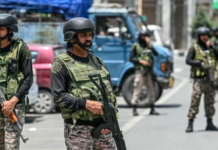When the United Front government with CPI participation came into power in West Bengal in February 1967, some active and vocal groups emerged. One of them under the leadership of Charu Majumdar and Kanu Sanyal, insisted on developing militancy on the peasant front, and preparing peasants for an armed struggle.
Initially, the leaders preached massive participation of peasants for forcible occupation of benami land but later on they emphasised liquidation of class enemies through the use of guerrilla tactics. Thus, mass movements were replaced by underground small group squads. This guerrilla activity of Naxalbari movement struck most in West Bengal and Andhra Pradesh and later on in Bihar also.
The members of the last three tribes were those who had migrated from Chotanagpur (Bihar) to work in tea-gardens in Darjeeling district. Landowners were called Jotedars and tenants were called adhiaii. The status of adhiari was precarious. They were so much exploited and treated like bonded labour that it led to peasant revolt in the 1950s and the 1960s.
Kanu Sanyal and others made their first entry amongst the exploited peasants in the 1960s, demanding abolition of zamindari, land to the tiller, prevention of tenant eviction, etc. The call given by the Kisan Sabha to peasants in the late 1950s and the early 1960s for regaining possession of benami land was: reap and store the harvest at your own place, ask jotedars to furnish proof of their landownership before the peasant committee, arm yourself to protect the crop and save your crop from the police.
In the second phase of Naxalbari peasant uprising in the late 60s and early 1970s, secret combat groups were formed and peasants were urged to seize the lands of jotedars and of the plantation workers who had purchased land from poor peasants, cultivate the seized land and retain all the produce from lands, ask landlord for food and if he refused, take it by force, deprive jotedar of his firearms. The 1967 Naxalbari uprising in Naxalbari area was suppressed through police action, but the revolt was renewed by August-September 1968 and continued up to 1972.
R.K. Mukherjee has analysed this movement in terms of relationship between social structure and social change. He argues that although the declared intention of the movement was capturing state power, in reality, the revolt was not directed against the system but against its excesses. It was the exchange of goods between the peasant and the owner landlord that was sought to be properly regulated.
(Article shared by Puja Mondal on yourarticlelibrary.com)
- Roots of the unrest:
Oppressed population, including tribes and rural dalits, wanted their share of land which was denied to them for generations. Left wing groups had been trying to channelize the demands to organize peasant uprising, inspired by Mao’s Chinese adventure, to ‘overthrow the elitist rule’. 2500 villages in Telanganaa had formed a commune in 1946 to achieve the same objective.
5th and 9th schedules were inserted in the constitution of India specifically to tackle this issue. 5th schedule speaks of protection of forest land inhabited by tribes. A governor is supposed to appoint a tribal committee which would be responsible for land distribution. 9th schedule dictates state to acquire land owned by elites for hundreds of years and re-distributing it among working peasants.
(Not so) Shockingly, not a single governor has formed a tribal committee to regulate forest land. Only three states (J&K, WB & Kerala) have implemented land ceiling laws stipulated by schedule 9, two of them were under communist governments. The laws still remain obscured in labyrinths of the administration, waiting for implementation. And the the wait is agonizing. This is the key to the Naxalism issue.
Landless farmers and peasants feel cheated for being denied cultivable lands on which they toiled for a pittance. Naxalite groups have systematically capitalized on this resentment. The tribesmen, already isolated due to pathetic infrastructure, are being systematically turned against the democratic system in favor of a communist regime.
- Naxalism Today:
According to the RAW, Naxalism is the biggest internal security threat to India. Home Secretary GK Pillai has stated that the objective of Naxalite movement is overthrowing of Indian democratic system by 2050. Increasing military expertise shown by the Naxalites is indeed alarming. Heavy casualties suffered by army at Dantewada provide a haunting testimony to their preparedness.
There are several ongoing attacks and counter-attacks between the armed forces and the Nnaxalites. Slowly, few factions of uprising are turning towards politics. However, the general approach from both the sides is that of distrust.
Naxalism has 50 years of bloody history. Both the sides have made sensational claims about wrongdoings of the other side. The prolonged struggle has started a vicious cycle of distrust and attacks. Unless the circle breaks, the possibilities of a mutually acceptable solution is bleak.
- So what do they really want?:
Frankly, what the Naxal leaders want is of little importance. There are far too many factions and huge difference of opinion among them. What really should be asked is, what forces poor people to raise guns?
The people in Naxalite zone want exactly the same things we want. Basic amenities, infrastructure and opportunities for growth. We have to accept one fact, they have been denied their fair share for generations. Forests which should have been regulated by their consent, are indiscriminately exploited by industrial lobby with the backing of government. The land which constitution grants them is still owned by a select few. Utter lack of a single modern facility exacerbates the issue.
They live in our country but worlds separate them from us. All they want is living in the same world in which we live. Everything else above that is a result of politics and personal ambitions.
(Curtsey QUORA.COM)





